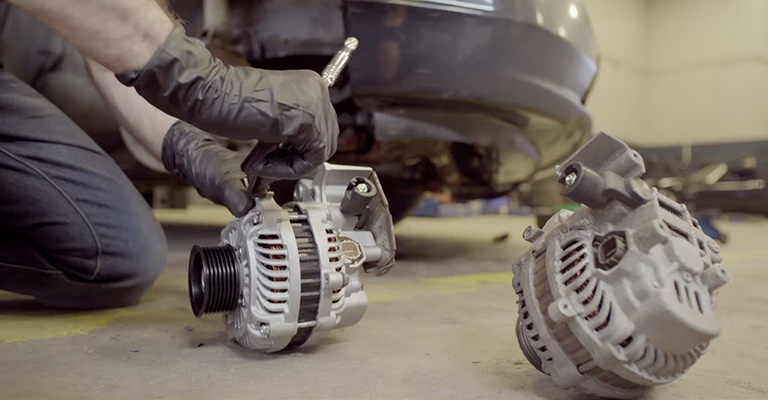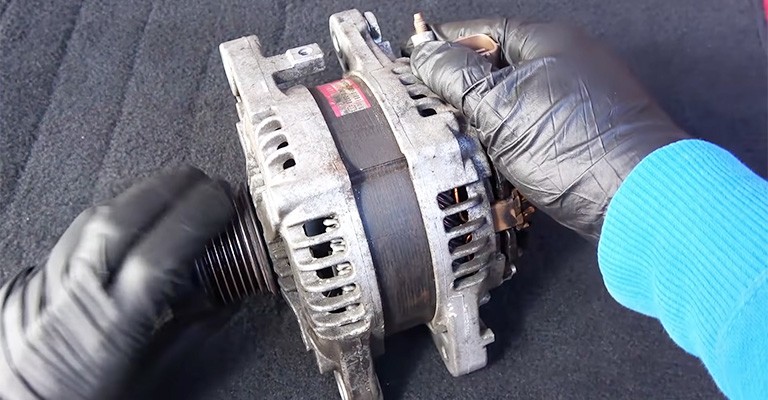The Honda Element is a unique and versatile compact SUV that offers spacious interiors, practical features, and reliable performance. However, like any other vehicle, it may require routine maintenance and occasional repairs.
One of the components that can malfunction in the Honda Element is the alternator, which is responsible for keeping the battery charged and the electrical system running smoothly.
If you are a Honda Element owner experiencing issues with your alternator, you may be interested in the cost of replacement.
In this article, we will explore the factors that can affect the Honda Element alternator replacement cost and provide you with valuable information to help you make an informed decision about repairing your vehicle.

How Much Does It Cost To Replace A Honda Element Alternator?
It costs between $459 and $689 on average to replace a Honda Element alternator. It is estimated that labor costs will range from $167 to $211, while parts will cost between $291 and $478.
You may be charged a different price for Alternator Replacement depending on your location and vehicle.
The numbers will vary depending on the auto part that needs to be repaired, the model of the car, and the cost of labor.
Changing an alternator takes about 2 hours, which is about the same time it takes to fix a driveline and just a little faster than replacing a clutch.
Alternatively, if the cost of a new alternator is too high, your mechanic might be able to provide you with a remanufactured or rebuilt alternator. Any potential problems should be covered by the warranty on your purchases.
How Does The Alternator Work?

An alternator is attached to an engine, and it generates power when turned by the serpentine belt or drive belt. Electricity is created when it spins, which is regulated by a voltage regulator and rectified by the rectifier.
During alternator operation, alternating current (AC) is produced, which is rectified by rectifier diodes into usable direct current (DC).
How Urgent Is An Alternator Repair?
A malfunctioning alternator will result in the battery not charging, which will result in the car not functioning properly.
You may be running late if your vehicle stalls and doesn’t start. There is a possibility that some safety components, like the headlights, might not function when you need them.
Additionally, an alternator that is faulty can cause certain electrical systems to be overcharged or undercharged, resulting in damage.
In the event that the problem with the alternator is not resolved, you could end up having to make additional repairs.
It’s important to have your alternator inspected by a reputable auto repair service whenever you notice bad alternator symptoms.
Regularly checking an old alternator can even be beneficial, such as when you get your oil changed or have your tires rotated.
Before Repairing The Alternator

It is important for the mechanic to inspect the entire charging system before installing a new alternator, including the cable connections and the battery’s condition.
Steps When Replacing An Alternator
- All components of the charging system should be inspected (battery, cables, alternator).
- Make sure the drive belts are in good condition.
- Perform an alternator output test.
- If the alternator is faulty, it should be removed and replaced.
- Test the output of the alternator again.
Our Recommendation For Alternator Replacements
Every time you have your vehicle serviced, make sure the charging system is being inspected. It is also recommended that the mechanic clean and tightens the battery cables during every major service.
How Do I Load Test An Alternator?

Voltmeters and multimeters are required for load testing alternators. The steps are as follows:
Battery assessment
After turning off the engine, connect the multimeter leads to the battery terminals. Connect the positive terminal to the red lead and the negative lead to the black lead. Battery voltage should be between 12.6 and 13.2 volts when fully charged.
Alternator assessment
Start the engine. The multimeter voltage should remain between 12-14 volts when the engine runs at around 1000 RPM.
Load the engine
Turn on accessories (such as headlights, radio, and windshield wipers.) The voltage shouldn’t drop below 12V or rise above 14V.
While the engine is running, any readings that are out of range may signal a problem with your alternator.
How Often Do Alternators Need To Be Replaced?

Alternators fail fairly frequently, but they can last well over 100,000 miles without incident. It is possible for an alternator to be shorted in life if it is driven under harsh conditions or equipped with custom power accessories.
Can I Drive With An Alternator Problem?
When the alternator has completely failed, a car must be towed to a repair shop if it has a weak alternator.
What Are The Symptoms Related To A Bad Alternator?
As a result of a failing alternator, the dashboard battery warning light will come on while you’re driving. Within a short period of time, the vehicle will lose all power, stall, and will not start again with a jump start.
Depending on the engine speed, a failing alternator bearing can produce a grinding noise. Your car may need an alternator repair if you notice the following signs:
Lit dashboard warning lights: An illuminated battery light, check engine light, or charging system light may indicate a problem with the alternator.
A burning odor: A burned smell may indicate a problem with the alternator pulley or drive belt.
Whining or squealing noises: This can be caused by an unaligned alternator pulley or worn-out pulley bearings.
Electrical system concerns: Damaged alternators may cause issues with your radio, power windows, and air conditioning.
Dim or too-bright lights: When the alternator is damaged, the headlights may receive too little or too much power.
Hard starting or stalling engine: When the battery isn’t properly charged (because the alternator isn’t working), the car won’t start.
Dead battery: When the engine is running, the alternator isn’t charging the battery.
How Do I Replace An Alternator?
Professional mechanics replace a failed alternator as follows:
- The negative battery cable needs to be disconnected.
- From the back of the alternator, disconnect the cable connections.
- The belt tensioner should be loosened so the drive belt can be removed.
- The alternator bracket is connected to the belt by mounting bolts. Remove the mounting bolts.
- The old alternator should be removed from the bracket.
- Ensure that everything matches, including the mounting bolt holes, between the new and old alternators.
- Ratchet the mounting bolts of the new alternator into place.
- All cable connections should be reinstalled after the drive belt is slipped back in position with the tensioner arm.
- Use a multimeter to test the alternator output after the installation has been reviewed.
Tips: Before installing the battery, make sure it is fully charged. It is possible to damage the alternator when the battery is charged with the new alternator.
Final Words
You use your alternator to charge your battery, which powers your car’s electronics like the radio and air conditioning.
Your vehicle also needs a battery to run. If your alternator malfunctions, you will not be able to charge your vehicle’s battery, and your car will eventually stop running.

Leave a Reply